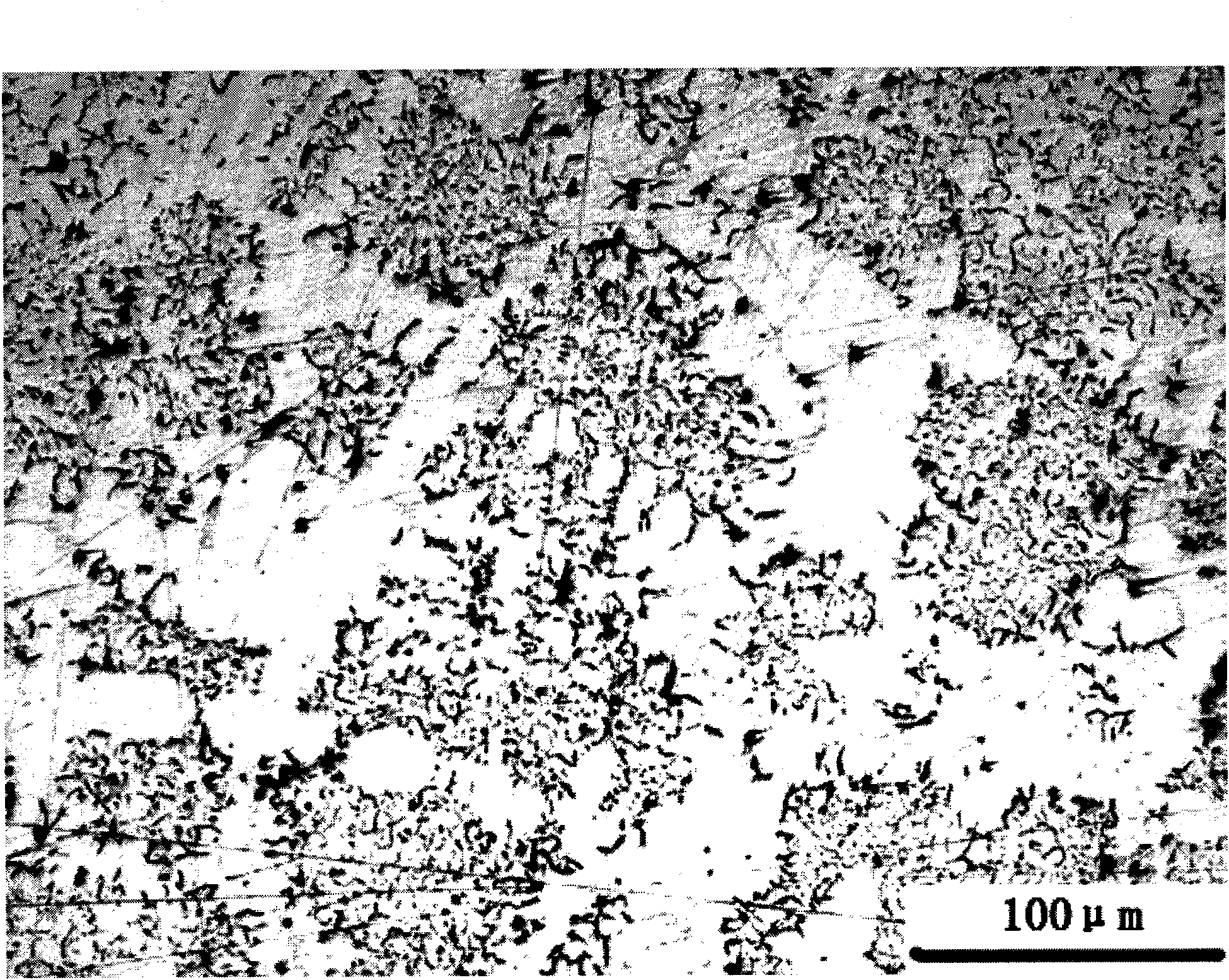Compound inoculant used for producing D-type graphite cast iron and preparation method thereof
A composite inoculant and graphite cast iron technology, applied in the field of inoculants, can solve problems such as a lot of research results, achieve the effects of reducing adverse effects, reducing residual stress, and improving cutting performance
- Summary
- Abstract
- Description
- Claims
- Application Information
AI Technical Summary
Problems solved by technology
Method used
Image
Examples
Embodiment 1
[0022] Embodiment 1: With the prepared raw material, according to the method for layered charging, raw material is packed in the crucible of induction furnace, the sequence of layered furnace charging and the weight percent of raw material are: scrap steel 9.3%, ferrosilicon 11.2% %, pure magnesium ingot 2.5%, pure aluminum ingot 0.8%, pure antimony ingot 1.0%, rare earth ferrosilicon alloy 20%, titanium iron 24%, silicon calcium alloy 10%, silicon barium alloy 10%, ferrosilicon 11.2%. Melt the loaded raw materials, stir them evenly, and cast them out of the oven; after solidification and cooling, break them into 3-8mm particle size to obtain the composite inoculant. The purpose of crushing into the above particle size is to facilitate the absorption of molten iron.
[0023] The alloy content of the composite inoculant that present embodiment obtains is: magnesium (Mg) 2.0%, rare earth (RE) 6.0%, titanium (Ti) 7.0%, aluminum (Al) 2.0%, antimony (Sb) 1.0%, calcium ( Ca) 3.0%, ...
Embodiment 2
[0024] Embodiment 2: The difference between this embodiment and Embodiment 1 is that: when producing this composite inoculant, the amount of raw materials charged is: 3.93% of scrap steel, 15.8% of ferrosilicon, 1.25% of pure magnesium ingot, and 2.32% of pure aluminum ingot , pure antimony ingot 0.5%, rare earth ferrosilicon alloy 26.7%, ferro-titanium 13.5%, calcium-silicon alloy 16.7%, barium-silicon alloy 3.5%, ferrosilicon 15.8%. The alloy content of the obtained composite inoculant is: magnesium (Mg) 1.0%, rare earth (RE) 8.0%, titanium (Ti) 4.0%, aluminum (Al) 3.0%, antimony (Sb) 0.5%, calcium (Ca) 5.0% %, barium (Ba) 1.0%, silicon (Si) 50%, and the balance is iron (Fe).
Embodiment 3
[0025] Embodiment 3: The difference between this embodiment and Embodiment 1 is that: when producing the composite inoculant, the amount of raw materials charged is: 9.3% of scrap steel, 10.0% of ferrosilicon, 5.0% of pure magnesium ingot, and 0.0% of pure aluminum ingot , pure antimony ingot 2.0%, rare earth ferrosilicon alloy 13.5%, ferro-titanium 30.0%, silicon-calcium alloy 6.7%, silicon-barium alloy 13.5%, ferrosilicon 10.0%. The alloy content of the composite inoculant obtained in the present embodiment is: magnesium (Mg) 4.0%, rare earth (RE) 4.0%, titanium (Ti) 9.0%, aluminum (Al) 1.5%, antimony (Sb) 2.0%, calcium ( Ca) 2.0%, barium (Ba) 4.0%, silicon (Si) 35%, and the balance is iron (Fe).
[0026] Example of use: The use of this composite inoculant in the production of Cummins diesel engine cylinders under the conditions of cupola-electric furnace dual smelting:
[0027] Cummins diesel engine cylinder block is made of HT250 cast iron, which requires high compactness, ...
PUM
| Property | Measurement | Unit |
|---|---|---|
| Granularity | aaaaa | aaaaa |
Abstract
Description
Claims
Application Information
 Login to View More
Login to View More - R&D
- Intellectual Property
- Life Sciences
- Materials
- Tech Scout
- Unparalleled Data Quality
- Higher Quality Content
- 60% Fewer Hallucinations
Browse by: Latest US Patents, China's latest patents, Technical Efficacy Thesaurus, Application Domain, Technology Topic, Popular Technical Reports.
© 2025 PatSnap. All rights reserved.Legal|Privacy policy|Modern Slavery Act Transparency Statement|Sitemap|About US| Contact US: help@patsnap.com

